A Culinary & Medicinal King – The King Tuber Oyster Mushroom
Before I get into the mushroom side of things, let’s take a look at 3 not-so-good statistics about the current state of affairs in India –
- 2022 was the hottest summer in India in the last 10 years with temperatures in parts reaching 49 degrees Celsius.
- According to the latest National Family Health Survey (NFHS-5), India witnessed a 62% increase in the number of overweight children from 2016 – 2020. This alarming statistic is an indication that if neglected, we might face an obesity crisis.
- Despite the blanket ban on plastics nationally, India still generates over 26,000 Tonnes of plastic every day with 60% of this ending up in landfills.
So, to put it simply- global warming is showing its true colors, our population is getting more obese by the day and our lands are being choked by plastic waste.
The million-dollar question on your mind now must be – what does all this have to do with mushrooms?!
Well, let’s find out!
As humans, we are drawn to mushrooms because of the unusual physical characteristics of their fruitbodies which magically appear after the first rains in fields and woodlands. Mycelium, which might not be visible, but is passively present within the ground below, waiting for favorable conditions.
Pleurotus tuber-regium has a similar story for us. This beautiful ochre colored mushroom was first stumbled upon by a member of our Cultivation Team at Nuvedo,while on a trip through the tropical jungles of Goa. He was quick to grab his camera and send us a couple of photos of this unique looking mushroom. Little did we know that this mushroom would soon be the reason for a lot of research, experiments, discussions and sleepless nights in our journey to work with the most healing mushrooms out there.
Ethnomycological Significance
Pleurotus tuber regium or King Tuber Oyster mushroom as it is commonly called is a relatively new mushroom for a lot of us in the mushroom space. They have been used by communities in West Africa and even in parts of North East India for many centuries as both an edible delight and also as folk medicine. These are not to be confused with the popular gourmet mushroom King Oyster (or Pleurotus eryngii) though they both share the characteristic feature of growing from the top surface of the substrate, rather than sideways like your conventional Oyster mushrooms do. Apart from this feature King Tuber and King Oyster mushrooms are two very different mushrooms. This mushroom derives its name from its unique ability to form truffle-like tubers underground, which are actually hard bundles of mycelium called sclerotia (which also act as food reserves for fungi). Apart from being a culinary delight, sclerotia contain a considerable amount of polysaccharides that are responsible for the multitude of medicinal properties that these mushrooms exhibit. If these facts haven’t blown your mind yet, let me tell you more!
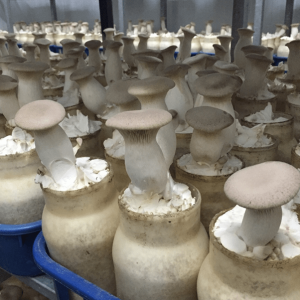
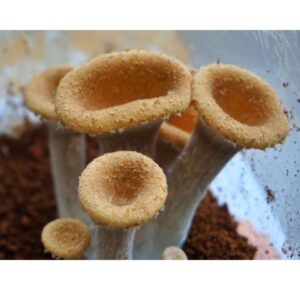
Heat Tolerant Mushroom
King Tuber Oyster mushrooms are one among the most heat tolerant cultivable mushrooms out there, capable of withstanding temperatures up to 40 degrees Celsius! Now that’s one hot mushroom! With temperatures around the world increasing year after year, the effects of global warming cannot be dismissed. Keeping this in mind, these mushrooms have the potential to become a food source in places where other crops might find it hard to survive due to high temperatures.
These mushrooms have a lot of potential for commercial cultivation but a lot more research needs to be done to develop commercial strains which have superior yields before these mushrooms can become available to the masses. As of today, these mushrooms are a rare delicacy that is wild foraged from tropical forests in Africa, Asia, and Australasia.
In the wild, King Tuber Oysters can be seen growing from rotting wood or from the soil. In the forests of Nigeria, these mushrooms can be seen growing around the African breadfruit tree. They are considered primary decomposers and can be cultivated on lignocellulosic waste similar to other gourmet and medicinal mushrooms. In their natural habitat, these mushrooms first form a thick bundle of mycelium underground, the sclerotia. Under favorable conditions, the fruiting bodies start to emerge from the sclerotia and appear above ground as beautiful light ochre mushrooms with funnel-shaped caps. These caps turn flat and proceed to turn wavy after the mushrooms reach full maturity. The sclerotia can be harvested and used to grow these mushrooms by simply planting it inside the soil, the same way you do with seeds!
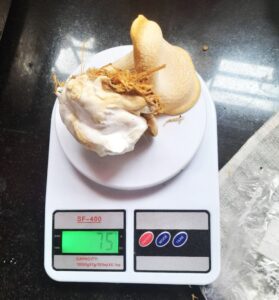
Medicinal Uses
Traditionally these mushrooms have been used in folk medicine in Ghana (4) for the treatment of a variety of health conditions including asthma, and high blood pressure and even to assist in weight gain for malnourished children. For all these purposes the mushroom/sclerotia is dried and powdered first and then used in soups or broths or even as an additive to flour used in cooking. One quick search for this mushroom on google will leave you with a multitude of research papers that show the therapeutic benefits of this special fungus.
King Tuber Oyster mushroom contain bioactive molecules which have been shown to help with-
- Lowering high blood pressure (2)
- Lowering high blood sugar (1)
- Lowering Cholesterol (1)
- Anti-Tumor/Cancer: (2,5)
- Anti-microbial properties (for Herpes Simplex) (2) (5)
- Anti-Obesity (2)
- Liver protection (2, 5)
Apart from medicinal benefits, King Tuber Oysters are also very high in potassium(3), anti-oxidants (2), and dietary fiber (equivalent to legumes or even seaweed)(5). It is an excellent prebiotic (2) and has also been explored as one of the few vegetarian sources of Glucosamine (5) which is used by patients suffering from various joint, bone, and inflammatory diseases such as arthritis.
Another really interesting property of this mushroom is its ability to break down polyethylene, which is a commonly used type of plastic! Don’t believe me, see the result of the study for yourself! As can be seen below, Pleurotus Tuber regium was able to decrease the weight of the polyethylene strips by a good 13.25% which is almost 50% higher than that compared to Pleurotus pulmonarius.
So we have with us a rare mushroom that grows in tropical jungles, is capable of withstanding scorching high temperatures, has the potential to treat a multitude of health conditions, and can eat plastic to top it off it also happens to be super tasty!
The obvious question most of you have right now would be where can I find these mushrooms? Or how do I cultivate these mushrooms at home? Don’t worry, we got you covered! Over the last year, our R&D team at Nuvedo HQ has been busy tinkering and finding a way to bring this powerhouse of a mushroom to your hands. After a lot of trial and error, we were successfully able to come up with the cultivation technology for this amazing mushroom which is now available for you to experience at home in the form of an easy-to-use grow kit!
You can grab one here: https://nuvedo.com/product/king-tuber-oyster-mushroom-growing-kit/

One last point that I want to touch upon before concluding is the culinary nature of King Tuber Oyster mushroom. Due to its high fiber content, the texture of the caps can be quite chewy compared to other mushrooms. Also, the stipe of the mushroom is hard and difficult to chew but brings in a unique texture, unlike any other variety. Throwing the stem away is not advised because there are a lot of polysaccharides and bioactive molecules present in it. You can chop them up or put them in the blender and make a paste out of it, which can later be added to soups or brother. The blended mushroom can be used in a similar fashion as a grated coconut!

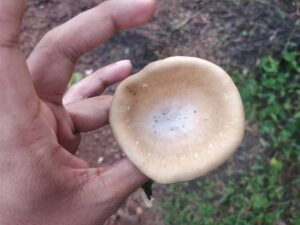
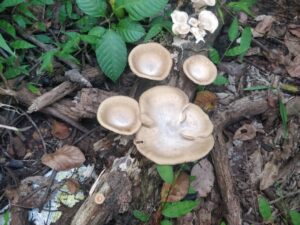


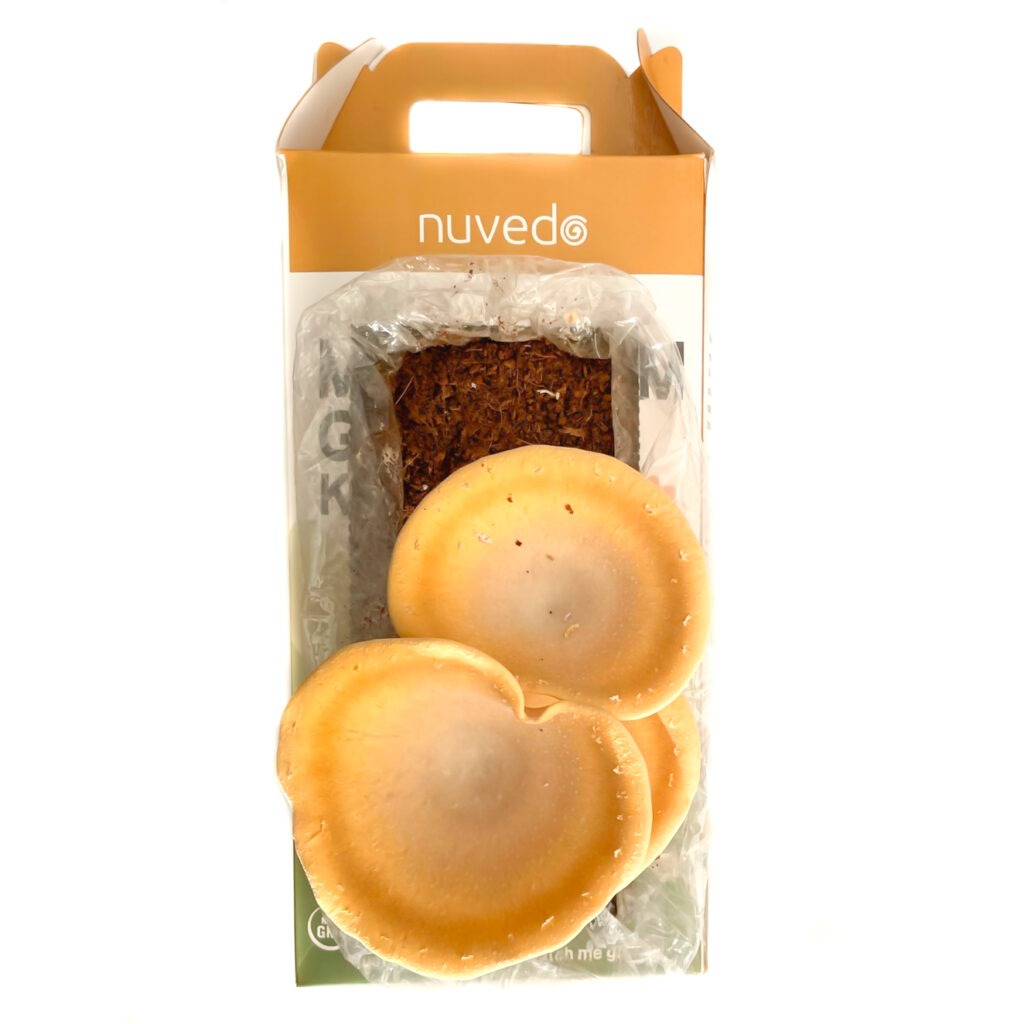
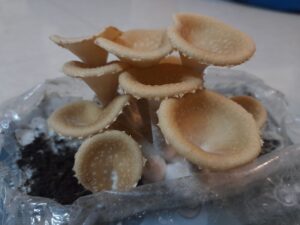
 Jashid is the co-founder of Nuvedo. An IIM graduate, with a bachelors in manufacturing engineering from BITS Pilani, his interest with fungi and mushrooms started with looking for alternate sources of vegetarian protein. He loves talking about mushrooms, spending time with them and studying their behavior in all shapes and forms. The role of fungi in the natural ecosystem, with mushrooms being at the forefront, led him to explore their structures, benefits and cultivation. Bringing his experience in retail and sustainability together, through a lens of permaculture, he cofounded Nuvedo with the aim of bringing legitimate, gourmet, and medicinal mushrooms to Indian people. He is committed towards spreading the nutritive and therapeutic properties of mushrooms while building an ecosystem of trust with the community. His love for people and passion for mushrooms has evoked the birth of this organization.
Jashid is the co-founder of Nuvedo. An IIM graduate, with a bachelors in manufacturing engineering from BITS Pilani, his interest with fungi and mushrooms started with looking for alternate sources of vegetarian protein. He loves talking about mushrooms, spending time with them and studying their behavior in all shapes and forms. The role of fungi in the natural ecosystem, with mushrooms being at the forefront, led him to explore their structures, benefits and cultivation. Bringing his experience in retail and sustainability together, through a lens of permaculture, he cofounded Nuvedo with the aim of bringing legitimate, gourmet, and medicinal mushrooms to Indian people. He is committed towards spreading the nutritive and therapeutic properties of mushrooms while building an ecosystem of trust with the community. His love for people and passion for mushrooms has evoked the birth of this organization.